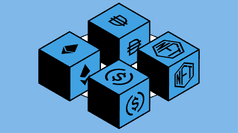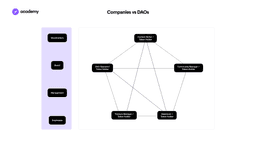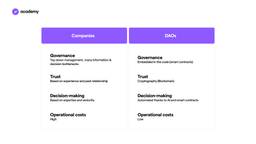DAO: Power to the Crypto Communities
December 27, 2021
7 min

Our story begins in 2013, when 19-year-old Vitalik Buterin wrote these words in Bitcoin Magazine:
“What if, with the power of modern information technology, we can encode the mission statement into code; that is, create an inviolable contract that generates revenue, pays people to perform some function, and finds hardware for itself to run on, all without any need for top-down human direction?”
It was then, or shortly before, that the idea of DAO was born.
What is a DAO?
A decentralised autonomous organisation is a type of organisation automated through smart contracts and with a decentralised structure.
Essentially, they are blockchain-based organisations that are collectively owned and managed by their own team and users.
Smart contracts define the rules of the organisation but also perform governance functions such as voting. Most of the important decisions in DAOs start as proposals and are ultimately decided by the vote of the members that is recorded on a blockchain.
This method also regulates the community treasury management, thus providing more transparency than in conventional organisations.
The growth of DAOs
Today we find ourselves in what seems to be the eve of the DAO era. Past the summer of DeFi in 2020, past a 2021 dedicated to NFTs, 2022 seems to point us in this direction.
If DeFi protocols and NFTs are the products and services of the blockchain, DAOs are the tool that allows them to be governed and given direction, in the most consistent way for this sector: in a decentralised way.
Many crypto projects started under the direction of companies or foundations that are gradually giving way to DAOs (see MakerDAO), while others are born directly as DAOs.
The socio-economic context also justifies this trend, if we think of the loneliness and inactivity that the pandemic has caused, leading many to seek connections and take action online.
Not only that, but this social condition is compounded by the strong tendency to self-employment or to quit and rethink one’s relationship with work. The increased adoption of cryptocurrencies and NFTs have been the icing on the cake that has brought many people around the world closer to DAOs.
Today there is a DAO for everything: Collecting NFTs, Socialising, Developing software, E sports, Musicians, Media, Education, Public funding.
You can see statistics on DAOs today on this site.
What kind of an organisation is a DAO?
A DAO can be both for-profit and non-profit, and is similar in structure to a cooperative society.
Different models of DAOs are emerging, such as Community DAOs and Investment DAOs.
The first type is the most common and spontaneous form of DAO: citizens of the Internet come together out of common interests and mindsets, and these ideas are then transformed into the DAO’s mission.
Usually, these DAOs start with an interaction on social media, an idea or wish, which leads a group of like-minded people to create a Telegram group or a Discord server.
Investment or Venture DAOs on the other hand are a way for communities to invest in projects that are in their early stages. They typically have an on-chain component in the form of smart contracts that manage the operations of the DAO and an off-chain component that provides the legal structure of the DAO.
The investment process of a Venture DAO is different from a typical venture fund, as each member can act as a lead investor and bring investment proposals to the community. The decision to invest is then based on the results of the vote of the entire DAO, not an investment board. According to its smart contracts, DAO members can have the right to terminate their participation at any time, whereas typical venture investments require investors to remain in the fund for a certain period of time.
A DAO’s economy
To initially finance itself, a DAO can launch crowdfunding on the blockchain, without the need for any intermediary.
The funds collected and then earned are usually kept in a Treasury, i.e. a common budget that may contain different types of assets:
- “Shares” (blue-chip NFTs and/or the official DAO token)
- Liquid (ETH, USDC, DAI, etc)
It usually consists of one or more multi-sig wallets, whose private keys are not held by one person, but by an extended group, and each transaction requires a minimum number of digital signatures.
Moreover, when a DAO begins to interest many, it often decides to issue its own token that can be purchased to join the DAO.
Think of the DAOs of crypto projects you may know best such as Uniswap or Compound, where the UNI and COMP tokens give voting rights, as well as having a market value.
However, these tokens do not always have a monetary value, such as AaveGotchi‘s GHST.
While for larger DAOs the requirement to participate is to buy the official token or a fraction of an NFT, in other cases you can become a member simply by working for the DAO.
DAOs and workers’ rights
And this is where we return to the social theme. Some interpret the DAO as a legacy of the labour movement, that movement born during the Industrial Revolution in which workers began to demand more rights, decent pay and better working conditions.
We have a better standard in Western countries today because of these struggles, but there is still much to be conquered.
In the US in particular, there has been a 62% increase in productivity since 1979, while hourly wages have only increased by 17.5%.
Here, union membership has plummeted over the last 30 years to a mere 9%. Even in Europe, the most unionised region, the rate fell below 30% after the 2008 crisis, without yet seeing a hint of recovery.
If governments do not support trade unions and workers no longer trust them, who will fight for workers’ rights?DAOs mark the birth of a new paradigm, and could be not only the collectives or unions of the future, but also the “companies” of Web 3.0.




